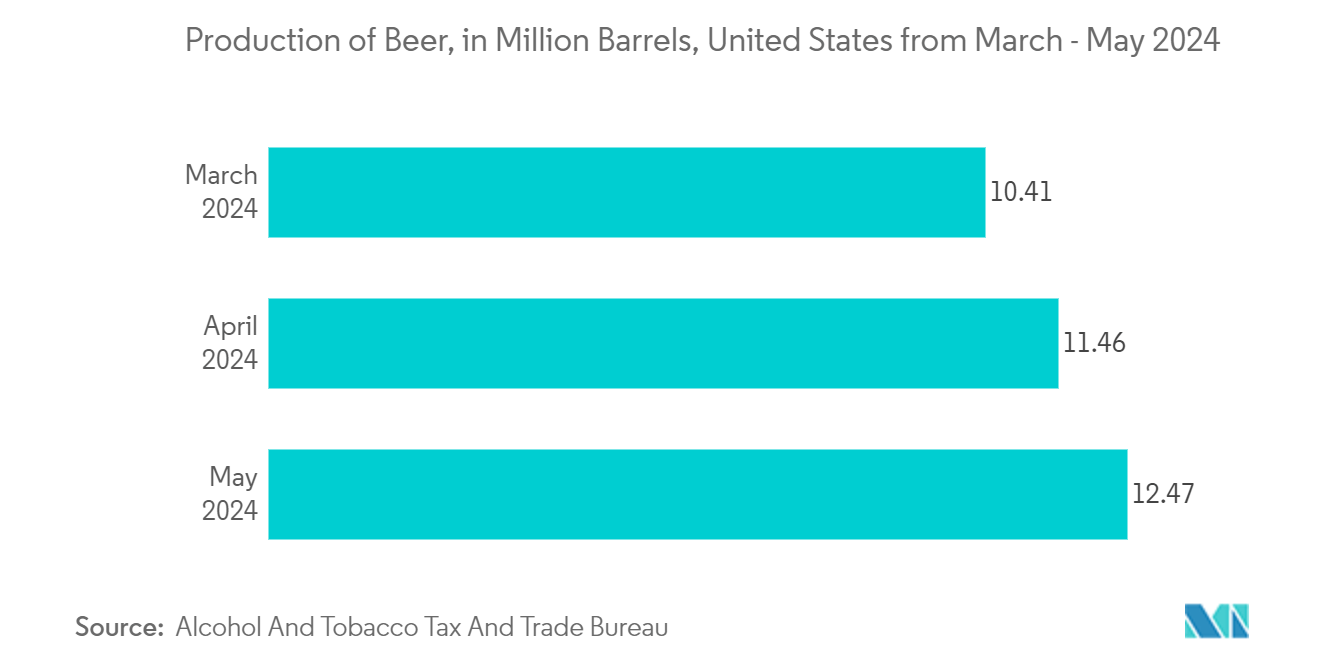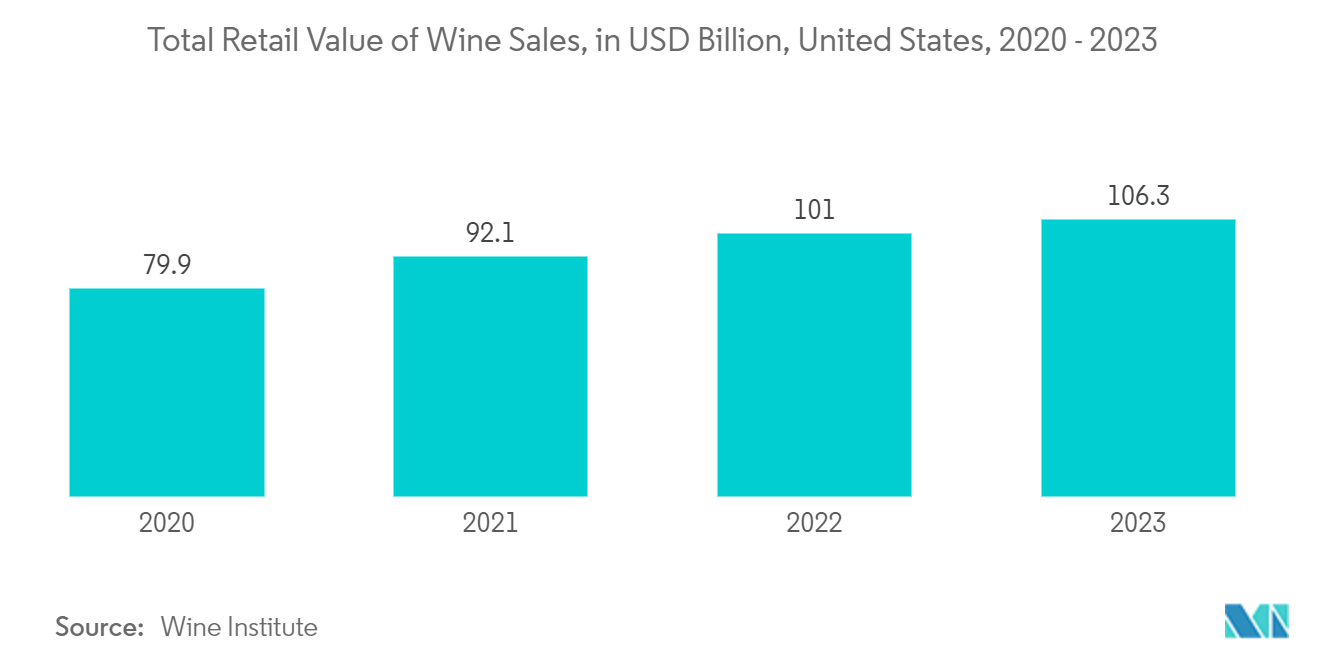Market Trends of North America Glass Bottles/Containers Industry
Alcoholic Beverage Segment is Expected to Witness Significant Growth
- Alcohol manufacturers are rolling out new versions of their products in glass bottles, a move anticipated to positively influence the market. By adopting glass packaging, these manufacturers aim to boost product appeal and reshape consumer perceptions, capitalizing on the premium image associated with glass. Glass bottles not only preserve the product's taste and quality more effectively but also offer heightened recyclability and an upscale feel. Many consumers equate glass packaging with superior beverage quality, often justifying a premium price tag.
- Moreover, glass facilitates unique and creative bottle designs, allowing brands to differentiate themselves on store shelves.
- This pivot to glass packaging resonates with the rising consumer demand for sustainable and eco-friendly options, given that glass is entirely recyclable and boasts multiple reuse capabilities.
- For example, in September 2024, Diageo-owned Johnnie Walker unveiled a limited edition Blue Label Ultra, showcasing the world's lightest 700ml glass bottle tailored for Scotch whisky. This pioneering packaging marks a notable leap in sustainable whisky bottling.
- The North American beer packaging sector is largely influenced by evolving cultural trends, a growing population, urbanization, and a surge in beer's popularity among younger demographics. Continued investments and a broadening beer distribution network across regions are likely to uphold these trends, potentially invigorating the market for glass bottles and containers.
- From March to May 2024, U.S. beer production in bottles and cans fluctuated between 10.41 million and 12.47 million barrels, underscoring the nation's demand for packaged beer. Even though the U.S. witnessed a 5% dip in beer production and imports in 2023, and craft brewer volume sales fell by 1%, the market remains buoyed by a rising beer consumption trend.
- The dip in production and imports could stem from shifts in consumer preferences, economic factors, or regulatory changes. Yet, the uptick in beer consumption hints at untapped growth and innovation avenues in the industry, possibly spurred by new beer varieties, intensified marketing, or evolving consumer behaviors.
- In North America, a growing segment of consumers is embracing sustainable lifestyles, notably in their efforts to curb plastic waste. This movement is propelling the wine and spirits market's shift towards glass bottles. Many consumers view glass bottles as more eco-friendly than their plastic counterparts and associate them with premium product quality. This perception resonates with environmentally-conscious consumers, often willing to pay a premium for sustainable packaging. Furthermore, looming government regulations aimed at curbing plastic usage could further amplify the demand for glass bottles in the alcoholic beverage sector.

United States is Expected to Account for Major Market Share
- The United States represents one of the world's largest packaging markets, featuring numerous key players producing glass bottles and containers for various industries, including food and beverage, personal care, and pharmaceuticals. The country's economic growth and rising consumer expenditure on food, drinks, pharmaceuticals, and personal care products drive the demand for glass bottle and container packaging solutions.
- This trend is further supported by the increasing preference for sustainable and recyclable packaging options, with glass being favored due to its eco-friendly properties. The growing craft beverage industry, particularly in beer and spirits, has also contributed to the increased demand for specialized glass packaging. The pharmaceutical sector's expansion, driven by an aging population and advancements in healthcare, has also bolstered the need for high-quality glass containers that meet stringent safety and preservation standards.
- The United States offers a favorable environment for business ventures due to its strong economy, comprehensive business immigration system, diverse consumer base, innovation-driven culture, and business-friendly policies. These factors make the USA an attractive destination for entrepreneurs and companies looking to expand or establish new operations. The country's robust infrastructure, advanced technology sector, and access to capital further enhance its appeal for businesses across various industries.
- The growth of e-commerce platforms and evolving consumer behaviors present significant opportunities for online retailers. The digital marketplace has experienced rapid expansion, driven by increased internet penetration, mobile device usage, and changing shopping habits. This shift has created a fertile ground for businesses to reach a wider audience and implement innovative sales strategies.These trends create potential opportunities for various industries, including glass packaging.
- As consumers become more environmentally conscious and seek sustainable solutions, glass packaging manufacturers can capitalize on the demand for recyclable and reusable containers. Additionally, the growing preference for premium and artisanal products in niche markets often aligns well with the perceived quality and aesthetic appeal of glass packaging, presenting further growth prospects for the industry.
- In the United States, Millennial and Gen X consumers have been driving the growth in wine consumption. These demographic groups have shown an increasing preference for wine, influencing market trends and product offerings. Their evolving tastes and purchasing habits have significantly impacted the wine industry's direction. The total retail value of wine sales in the US reached approximately USD 106.3 billion in 2023. This substantial figure reflects the robust nature of the American wine market and its continued expansion. The sales value growth indicates increased consumption and a potential shift towards premium or higher-priced wine products.
- This trend indicates an increasing demand for high-quality glass bottles in wine packaging. As consumers become more discerning, there is a growing emphasis on the overall presentation and quality of wine products. Glass bottles, particularly those of superior quality, play a crucial role in preserving the wine's integrity and enhancing its perceived value. The packaging industry, especially glass manufacturers, will likely benefit from this trend as wineries seek to meet consumer expectations for premium packaging solutions.


